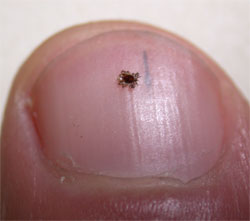Unless you live in the Northeast or the Midwest, Lyme Disease probably isn’t a much of a concern (not that there aren’t other little pests to worry about). There’s a “Lyme Belt” that includes Eastern PA, New Jersey, Southeastern NY, CT, and MA that constitutes the epicenter of the large majority of Lyme cases in the United States, and you don’t even have to be in the woods to get it; my father contracted Lyme disease in our backyard. For him, the flu-like symptoms were just a summer fever, and the red flags didn’t pop up until weeks later when he was blindsided by paralysis in half of his face (Bell’s Palsy). Even before I watched him battle his infection, I had always known about Lyme Disease, and felt confident in my ability to prevent and/or recognize it, but Borrelia burgdorferi is a tricky beast that still found a way to catch me by surprise.
The state of New York has not been kind to me. In 2008, I contracted the flu and tonsillitis after standing outside in subfreezing temperatures (17 degrees) for ten hours in a fenced in area of Times Square to watch a stupid crystal ball drop a couple dozen feet, thus denoting the commencement of a new year. I haven’t spoken to New York City since. This past summer, I baked in the heat for 9 hours standing along the rail at Belmont Park in Long Island to watch California Chrome finish outside of the money in the Belmont Stakes and choke away the Triple Crown. And, in 2013, I came away from an overnight backpacking trip in New York with Lyme Disease.
A week after my 25th birthday, my brother and I took an overnight trip in Harriman State Park on the 13th and 14th of July to break in some new hammocks that we bought. After climbing the summit of Tom Jones Mountain (What’s new pussycat?), we hiked a few miles into the backcountry and found a nice spot to pitch our hammocks. In retrospect, the campsite was poorly selected. It was in a grove full of tall grass, and we didn’t realize that bug nets are a necessity for hammock camping in the summer. It was tough to get comfortable and fall asleep as I was being eaten alive by mosquitos, and I awoke with a healthy amount of bites – around thirty or so. The following morning, we spent around an hour in the tall grass eating breakfast, drinking coffee, and packing up camp. Right before we left I took my shirt off to swap out with a clean one, and I found three deer ticks on me almost immediately. Fortunately, none of them were engorged and none of them had dug into me, so I removed them all, lathered myself in a heavy deet bath, and put on my other shirt. I’ve read that it usually takes 24 to 36 hours for the disease to be transmitted. I thought I was okay. I must have missed one.
They say the tell-tale sign of Lyme infection is a “bullseye” rash that forms around the area of the bite. Happens around a week or so after the infection. Happens in 70-80% of infections. I kept an open eye, almost expecting it, but it never happened. To be honest, in the first few weeks after the trip, I felt fantastic. No signs, no symptoms. The closest thing to a symptom (in retrospect) were the “cat naps” I developed a habit of taking in the afternoons when I was on vacation in Ocean City, NJ, a few weeks later, but they didn’t seem abnormal at the time. I was on vacation, a day at the beach usually takes a lot out of me, and I was only lying down with my eyes closed for a half hour or so. Nothing close to the type of exhaustion or fatigue that could be associated with an illness. To be fair, I’m not sure that this “cat napping” could be considered a lyme related symptom, but it may have been an indication that I was starting to fight off a robust and resilient bacterial infection.
Around the beginning of August (3 weeks after the bite), the flu symptoms hit. High fever (101-102), chills from head to toe, sweating (I woke up two or three times and my bed sheets were drenched), impressively painful body aches in my neck, shoulders, and back to the point that it was painful even when I was lying in bed or sitting down, and fatigue. I felt weak. I felt ill. More ill than I’ve ever felt before. My symptoms lasted around a week and a half. Knowing that I had been exposed to at least a few deer ticks up in New York a few weeks earlier, I called the doctor, who ran blood tests for Lyme that came back negative. A few days later, I started to feel better, and put Lyme out of my mind. I had meant to go back and get tested again in a few weeks as a precaution, but never did. Life got in the way. I forgot all about the deer ticks of Harriman State Park. I forgot that there was a strong possibility that I was infected. Through the fall, winter, and spring months, Borrelia burgdorferi was the last thing on my blissfully ignorant mind. But I was the only thing on Borrelia burgdorferi’s mind, as the bacteria was quietly and unassumingly setting up shop, preparing itself up to wreak havoc on my body.
In Part 2, the Lyme Disease rears its ugly head, I know what it feels like to be an old man, and my body becomes a microscopic battleground. Feel free to leave any comments about your own experiences with Lyme, and, as always, thanks for reading.




Pingback: Lyme Juice: The Bite and the Fight (Part II) | Keep Calm, Trek On